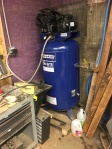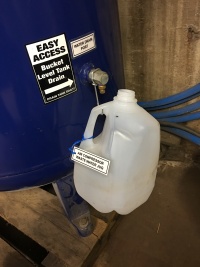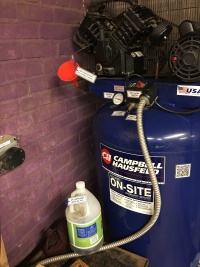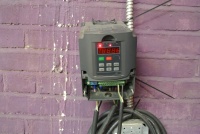Campbell Hausfeld Air Compressor
[Equipment|Back to list of Equipment]]

|
General
|
Operation
The air compressor provides on-demand compressed air to outlet locations in the space for utility use. It is typically left powered on (enabled), all the time. Be aware that it can unexpectedly start at any time. The tank pressure is typically maintained at 125 psig. When the tank pressure falls below a low-pressure set point, the unit's electric motor automatically starts to operate the compressor to rebuild/restore the tank pressure. When the tank pressure reaches a high-pressure set point, the electric motor automatically turns off, stopping the compressor. It remains enabled to automatically re-setart as needed to maintain tank pressure.
How to Turn it On (Enabled for automatic start/stop)
Notice the labeled red selector switch. Turn it from off to on. This will enable the automatic operation based on tank pressure. Know the electric motor may, or may not, immediately start to rotate the compressor, based on the tank pressure.
Safety
- Realize the enabled air compressor electric motor can and will automatically start at any time. Avoid entangling body parts in the (potentially) rotating machinery.
- Realize the compressed air in the tank is an energy source, even after electric power is removed. Vent the tank to atmospheric pressure before servicing to release this energy source.
- Realize the compressed air in the lines and at outlet locations is an energy source. Use caution when making connections and initiating flow to avoid unintended pressure release consequences.
- Compressed air is typically used to blow sawdust, metal chips, and dust from the equipment. Wear PPE (eye and ear protection) and use caution to avoid injury from contact with such flying debris.
Maintenance
The following should be done
Drain waste water condensate from the tank monthly, or as needed (Estimated time: 10 minutes)
Atmospheric air contains invisible moisture. Mechanically compressing this air causes the air to heat up. Hotter air holds more invisible moisture than colder air. When this initially hot air (at pressure in the tank) then cools, the invisible moisture will condense from the air as liquid water. Similarly, flow-related pressure changes in the lines and hoses will also cause moisture to condense as liquid water in lines and hoses. This liquid water is a contaminate that can accumulate. It can cause rust in the equipment and liquid water droplets may be expelled with the compressed air during use.
It is a simple-enough process to drain waste water condensate from the tank on a periodic basis.
- Notice the labeled jug and the drain outlet on the tank show in the picture.
- Position the jug under the drain outlet.
- Slowly rotate the drain outlet fitting to open it. Tank pressure will expel waste water from the tank into the jug.
- Rotate to close the drain outlet fitting when the flow changes from water to air and/or the jug is full.
- Dispose of the waste water (insert proper destination) and hang the empty labeled jug back on the hook, ready for the next use.
Change the oil in the air compressor on an annual basis (Estimated time: 30 minutes)
The oil in the compressor crankcase should be changed on an annual basis.
- Notice the labeled jug, funnel, level view port, drain plug, and fill port in the following picture.
- Procure new oil (enter spec and quantity here).
- Turn off electric power to the equipment.
- Loosen the fill port to first vent the compressor crankcase.
- Position the funnel and jug at the drain port (perhaps with a second person).
- Slowly open the drain port to flow used oil through the funnel into the jug.
- When the flow stops, close the drain plug.
- Wipe the funnel clean and re-use it to pour new oil into the fill port and stop when the level is centered in the view port.
- Dispose of the used oil (insert proper destination) and hang the empty labeled jug and funnel back on the hooks, ready for the next use.
Capacitors
If the compressor starts tripping the circuit breaker, the capacitors are most likely going bad. This happens every 5-10 years. The replacement capacitors are 270-320uF 330V@10000h (220-250V also works) 1-3/4" diameter x 4-1/4" tall, and 50uF 400V 1-3/4" diameter x 3-3/4" tall. In 2021 we used an "Allmost brand CBB60" and a "Motor Start Capacitor 270-324 MFD 220-250VAC", both from Amazon.
Documentation
This file File:HY02D223B.pdf is correct format wiki text as an incorrect PDF placeholder (to be changed) for the air compressor manual.



